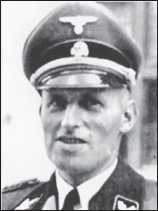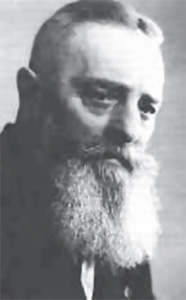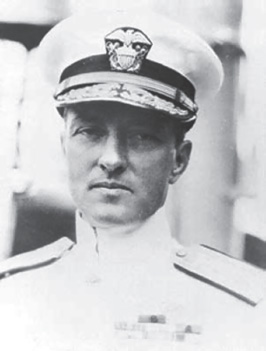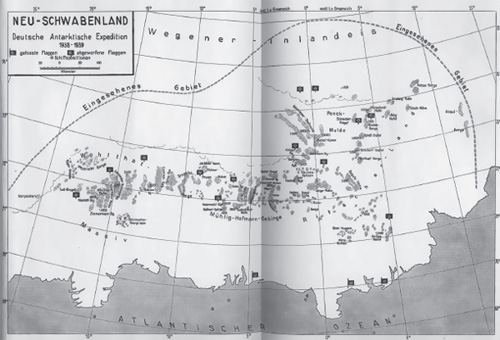Secret Journey to Planet Serpo (3 page)

THE GERMAN DISCS
In 1944, SS Commander Heinrich Himmler withdrew all secret technology and weapons development from under the control of Hermann Goering and relegated it to civil engineer SS General Hans Kammler, and it was removed to the massive Skoda Munitions Works near Pilsen, Czechoslovakia. By this action, Kammler became the third most powerful man in Nazi Germany. The Skoda factory produced the German Panzer tanks early in the war and had the capacity for large-scale metal castings, which were needed to build the discs. The scientific and technological foundations for the Nazi disc development came from Patala and was supplied to the SS scientists by the Society of Green Men who had set up an advisory colony in Berlin. There is evidence that the Germans manufactured up to twenty-five working models of the Haunebu type. This was the distinctive bell-shaped craft powered by a rather simple electrogravitation motor called the Kohler converter, developed by Captain Hans Kohler based on the Tesla coil. This motor converted the Earth's gravitational energy into electromagnetic power, but could also extract energy from the ambient vacuum in outer space. In this series, the
Haunebu I
was a small, two-man ship, but the
Haunebu II
was much larger and more sophisticated. It was reported to have a diameter of about seventy-five feet, and had the capacity to carry a full crew. The German SS plans for this craft, dated November 7, 1943, are available on the Internet. Also available are photos of the Haunebu in flight, clearly showing the German cross painted on the side and flanges, and a 7.5mm antitank gun mounted on a swivel turret, apparently identical to the gun then being used on German Panzer tanks.
*5
Other important antigravity weapons research was carried on near Prague, presumably at Skoda, primarily by Viktor Schauberger and Richard Miethe. Miethe, in cooperation with the Italians, developed the large helium-powered V-7 and the small one-man Vril models, which achieved a speed of 2,900 km/hr in flight tests. In a letter written by Schauberger to a friend, he gives information from his direct experience. He says:
The flying saucer which was flight-tested on the 19th of February 1945 near Prague and which attained a height of 15,000 meters in three minutes and a horizontal speed of 2,200 km/hr, was constructed according to a Model I built at Mauthausen concentration camp in collaboration with the first-class engineers and stress analysts assigned to me from the prisoners there. It was only after the end of the war that I came to hear . . . that further intensive development was in progress . . . at the works in Prague.

Nazi General Hans Kammler
In
German Secret Weapons of the Second World War,
Rudolf Lusar says, “The development . . . which had cost millions, was almost complete by the end of the war.” Noted Hungarian physicist-researcher Vladimir Terziski says that by this time the German technicians had built a huge version of the
Haunebu,
which was about 230 feet in diameter. This “dreadnought,” the
Haunebu IV
(see
plate 1
), was piloted by an all-volunteer, joint German-Japanese crew and sent on a “suicide” mission to Mars. According to Terziski, it crash-landed on Mars in January 1946 after a difficult eight-month flight. This means that it departed the Earth right around the time of Hitler's suicide and the German capitulation, which means that it could not have left from Germany. Terziski says that this mission left from the joint Nazi-alien base at Neuschwabenland in Antarctica (see next chapter). The Green Men died in the final days as Berlin was virtually destroyed by the bombings and advancing Allied armies. Their bodies were discovered by the Russians in the rubble, arranged in a circle. They were wearing German uniforms.
In April 1945, a French diplomat living in Switzerland wrote the following report:
The circular German fighter without wings or rudder suddenly overtook the four-engined Liberator, crossing its flight path at very high speed. When it passed in front of the formation, it gave off a number of little bluish clouds of smoke. A moment later the American bombers mysteriously caught fire, exploding in the air, while the German rocket had already disappeared over the horizon.
The circular fighter was the final product of the long years of Nazi research and experimentation in eight different areas: direct gyroscopic stabilization; television-controlled flight; vertical takeoff and landing; jam-free radio control combined with radar blinding; infrared search eyes; electrostatic weapon firing; hypercombustible gas combined with a total reaction turbine; and antigravityflight technology. This was the incredible Kugelblitz, or “lightning ball.” If it had emerged even six months earlier, the war could have turned out very differently. It was the last gasp of the Third Reich, but it was an ominous harbinger of things to come.
KAMMLER DISAPPEARS
In mid-April 1945, as General George S. Patton's Third Army rapidly approached Berlin on a direct eastern trajectory, General Eisenhower commanded him to halt and change direction. He was sent southeast toward Prague, Czechoslovakia, and then was told to stop at Pilsen, the home of the Skoda works. Patton obeyed these orders very reluctantly, since he had been intent on beating the Russians to Berlin. Evidently, Eisenhower had been informed by the OSS of the secret weapons development there under Kammler. Patton arrived at Skoda six days before the Russians, but Kammler was gone. On February 23, 1945, the newest engine of the Kugelblitz had been shipped out, and the shell was blown up. Two days later the underground plant at Kahla, Germany, was closed and all the slave workers were sent to Buchenwald to be gassed and cremated in accordance with the grisly Nazi credo, “Dead men tell no tales.” Kammler was in charge of the evacuation. He was never found. The various intelligence agencies of the Allied powers had gotten all the espionage reports, and were well aware of what was going on in Hitler's underground Alpine facilities. Consequently, the invading armies knew precisely what to look for. According to Italian author Renato Vesco in his book
Intercept UFO,
“tons of blueprints, company papers, lists of researchers, laboratory models, memoranda, reports, and notes that covered every sector of the war industry came pouring out of thousands of unlikely hiding places.” Most certainly, we can conclude from this that much of the antigravity information fell into Allied hands. At that point, it is very unlikely that the Allied powers understood where the antigravity technology had originated. The discovery of the bodies of the Green Men in Berlin might have offered a clue, but there was no other evidence that it came from Tibet. Undoubtedly, they believed that it had been developed by the German scientists.
DISC TECHNOLOGY AT WRIGHT-PATTERSON
Viktor Schauberger, the Austrian scientist who had designed the flying disc built at the Mauthausen concentration camp, was apprehended by U.S. intelligence agents immediately after the war, and was kept in their custody for nine months. The agents confiscated all his documents, notes, and prototypes, and interrogated him intensively. He was then sent to the United States to continue to work on his innovative antigravity disc.
Oddly enough, perhaps coincidentally, Dr. Eric Wang, a fellow Viennese aeronautical engineer, was then teaching at the University of Cincinnati. Wang had received his engineering degree at the Technical University of Vienna in 1935. Little or nothing is known about his movements after that until, in 1943, he was on the staff of the university where he taught engineering and mathematics. Presumably, he had emigrated to the United States before the war, as did many other German and Austrian scientists, including Albert Einstein. In 1949, he was recruited by the Air Force to work at Wright-Patterson AFB in the Office of Foreign Technology. This is where the crashed alien discs from New Mexico were brought for analysis and reverse engineering. Wang is known to have said that the flying disc technology he was working on for the Air Force was different than the Schauberger technology. We can reasonably conclude from that remark that Wang was working with Schauberger under Air Force auspices when Schauberger was sent to the United States, even before Wang officially went to work
for the Air Force. That would have been between 1945 and 1949. It is known that
Viktor Schauberger later joined research efforts in flying disc development in
Texas. It is believed that the original disc itself was destroyed by the
Germans, along with prototypes of the SchrieverHabermohl-Miethe model. This was
the legendary V-7. It is known that Klaus Habermohl was taken to the Soviet
Union and some think that the Russians succeeded in obtaining a prototype of the
V-7 when they arrived at Skoda. Miethe went to work for the United States and
Canada. So we can conclude from this that the Army Air Force (the precursor to the Air Force) knew all about electromagnetic antigravity disc technology, probably as early as 1944. However, as will be seen in the next chapter, in early 1947 the military learned just how deadly the discs could be in actual combat.

Viktor Schauberger
2
ANTARCTICA
Prior to the 1930s, the continent of Antarctica drew scant attention as a possible place to establish a permanent colony. There really was no reason why any civilized nation would want to consider such a frozen, forbidding land as a place for human habitation. But it did become a magnet for intrepid explorers who wanted to make noteworthy discoveries, or to be the first to reach the South Pole. Credit for the discovery of Antarctica is given to Russian naval officer Fabian Bellingshausen, who first sighted land in the Southern Ocean on January 28, 1820, and circumnavigated the continent twice. There were several expeditions by Europeans in the nineteenth century, notably by the British, the Belgians, and the Norwegians. From 1839 to 1843, daring British naval officer James Clark Ross charted much of the coastline and discovered and named the Ross Sea, Victoria Land, and the volcanoes Mt. Erebus and Mt. Terror, both named after expedition vessels. Ross was knighted upon his return to England, and also received the French Legion d'Honneur.
THE NAZI BASE
With the advent of aviation, reaching the South Pole by air became a real possibility, and it was accomplished by seasoned aviator Richard Evelyn Byrd on November 28, 1929, earning him the gold medal of the American Geographical Society. Byrd's expedition established a base camp on the Ross Ice Shelf, called “Little America,” and commenced exploration of the continent by snowshoe, snowmobile, dogsled, and airplane. Byrd's second Antarctic expedition in 1934 nearly ended in tragedy. He spent five winter months all by himself in a small meteorological advance station where he was overcome by carbon monoxide from a small heater, but he was rescued in time by team members from the base camp. This harrowing adventure was described in his book,
Alone,
first published in 1938.

Admiral Richard E. Byrd
Given this sparse international history of the rough-hewn exploration of the continent, it was surprising, even astonishing, that the Germans would seek to establish a colony in Antarctica in 1938. There had been two previous German expeditions, in 1901 and 1911, each lasting two years, but those pre-Nazi journeys offered no hint that the Germans actually wanted to live there. But the Nazis were very serious about this project. The preparations for the German Antarctic expedition of 1938 were massive and comprehensive. The Nazis even brought Richard Byrd, the preeminent world authority on Antarctica, to Hamburg prior to the mission departure to advise the members of the team. They also asked him to accompany the expedition, an invitation he declined. Byrd was a civilian at the time, and his agreement to counsel the team members did not, in any way, constitute sympathy with the Nazi regime. Byrd, of course, had to be aware of the German expansionist intentions, since Hitler had already taken over Austria. But after the Munich Agreement in September 1938, the world lapsed into the delusion that Hitler had no further territorial ambitions. Then there was the distinct possibility that Byrd went there on a U.S. government mission to covertly obtain information about Germany's plans for Antarctica.

Germany's 1938 Antarctic Mission Emblem
The Germans utilized the seaplane carrier
Schwabenland
for the 1938 journey. According to Russian ufologist Konstantin Ivanenko:
The
Schwabenland
sailed to Antarctica, commanded by Albert Richter [Ritscher], a veteran of cold-weather operations. The Richter [Ritscher] expedition's scientists used their large Dornier seaplanes to explore the polar wastes, emulating Admiral Richard E. Byrd's efforts a decade earlier. The German scientists discovered ice-free lakes (heated by underground volcanic features) and were able to land on them.
*6
It is widely believed that the Schwabenland's expedition was aimed at scouting out a secret base of operations.
The seaplanes dropped swastika flag pennons all over the Queen Maud Land area, staking out a widespread German territory amounting to 600,000 square kilometers (about 360,000 square miles). They then established a base in the Muhlig-Hofmann Mountains, very close to the Princess Astrid coast, which they referred to as Neuschwabenland, named after the duchy of Swabia, part of the original German kingdom.
NEUSCHWABENLAND
The legend and lore surrounding the Nazi Antarctic base is voluminous, bordering on overwhelming. Various writers say that German convoys started bringing in equipment to develop this base beginning in 1938. According to the Omega File:
Beginning in 1938 . . . the Nazi's [sic] commenced to send out numerous exploratory missions to the Queen Maud region of Antarctica. A steady stream of expeditions were reportedly sent out from [at the time] white supremacist South Africa. Over 230,000 square miles of the frozen continent were mapped from the air, and the Germans discovered vast regions that were surprisingly free of ice, as well as warm water lakes and cave inlets. One vast ice cave within the glacier was reportedly found to extend 30 miles to a large hot-water geothermal lake deep below.
In October 1939, one month after the beginning of World War II, the
Schwabenland
was turned over to the Luftwaffe, which means that Hermann Goering took over the project. On December 17, 1939, the ship again left Hamburg headed for Antarctica, loaded with scientists and equipment. This time they were going to build a permanent base. The Omega File says:

Map of Neuschwabenland; flags show German colonies
Various scientific teams were moved in to the area, including hunters, trappers, collectors and zoologists, botanists, agriculturists, plant specialists, mycologists, parasitologists, marine biologists, ornithologists, and many others. Numerous divisions of the German government were involved in the top secret project.
The development effort continued throughout the war. An article appearing in
The Plain Truth
magazine (U.S.) in June 1952 says, “. . . in 1940 the Nazis started to amass tractors, planes, sledges, gliders and all sorts of machinery and materials in the south polar regions” and “. . . for the next 4 years Nazi technicians built, on . . . Antarctica, the Fuhrer's Shangri-La.” The article goes on to say, “. . . they scooped out an entire mountain, built a new refuge completely camouflagedâa magic mountain hideaway.” According to the original
Bonjour
magazine, a Parisian publication in the 1950s, the Nazi engineers constructed buildings at this base in 1940 that could withstand temperatures up to â60° Fahrenheit. There are many cave inlets in this region, allowing submarine access to a relatively comfortable disembarkation. Engineer and physicist Vladimir Terziski says that the Germans populated a city called Neu Berlin under the ice with a community of scientists and workers that approximated forty thousand civilians by the end of the war. This city was just a small section of the vast Neuschwabenland colony under Queen Maud Land. Presumably, the population was supplied with food via merchant vessels from Argentina and by growing crops hydroponically. Then, of course, the Southern Ocean is rich with fish and marine animals. It is also possible that the Germans had begun agricultural projects in the warm-water lakes region of Antarctica.
THE RUINS OF KADATH
Considering that Germany was only one year away from embarking on the invasion of Poland, and thereby starting World War II, it is astounding that the Germans would have devoted such energy and so many resources to the development of a base on a frozen wasteland five thousand miles from Germany. Several other sources have claimed that Antarctica was actually previously Atlantis, which moved to the South Polar region as a result of a prehistoric pole shift.
*7
Since the Reptilians are known to have inhabited Atlantis, it is very possible that their colony remained underground after the shift and they were still living under Antarctica. Ivanenko says that Neu Berlin adjoins “the prehistoric ruins of Kadath [Ã la the novella by H. P. Lovecraft], which may have been built by settlers from the lost continent of Atlantis well over 100,000 years ago.” Another unnamed occult researcher claimed that “Neu Berlin has an alien quarter where Pleiadians, Zeta Reticulans, Reptoids, Men in Black, Aldeberani and other visitors from the stars dwell.”
LUNATIC LEADERS
It is not at all far-fetched to conclude from this that the Reptilians encouraged the Nazis to establish a colony adjoining theirs, possibly as a refuge in the event the war turned out badly. But more likely, this colony was to be a base for joint German-alien scientific and technological development for interplanetary travel and conquest.
*8
As we have already seen, the Nazis had executed a pact with the Reptilians living in Patala in 1933 that resulted in a transfer of advanced technology to Germany, including antigravity discs. This would explain why, as we will see below, the Nazis eventually moved all the aeronautical engineers and scientists involved in the development of the antigravity discs, as well as the prototypes themselves, to Neuschwabenland. At that early date, the Nazis were supremely confident of winning the war, and would not have been thinking about a refuge. It would, therefore, be reasonable to conclude that this is the real reasonâand the only reasonâthat the Nazis went to such trouble to build not just a base, but a city, under two miles of ice halfway around the globe. After all, they envisioned the conquest of the entire Eurasian landmass, so it's not as though they were so concerned about territorial deprivation that they would have to move to the South Pole to survive as a nation.
It appears that, even at this early stage, the Nazis were already anticipating travel to other planets alongside their Reptilian compatriots. It was from this Antarctic base that the joint German-Japanese suicide mission to Mars was launched in mid-1945 (see chapter 1). The German population knew nothing about any of this. It is certainly understandable that the Nazi leadership would not have wanted the German people to know about all these fantastic plans. They would surely have concluded that their leaders were raving lunatics! But perhaps the most important reason for the secrecy was the fact that the Nazi overlords had no intention of relocating the entire population of Germany to Neuschwabenland. This colony was to be reserved for only the purest specimens of the Aryan race.
ANTARCTIC SETTLEMENT WOMEN
By mid-1943, the Allies noticed heavy submarine traffic in the South Atlantic, and began to suspect that something unusual was going on. The Neuschwabenland base construction and settlement had been removed from the control of failed Luftwaffe chief Hermann Goering and was now under the control of Heinrich Himmler, who was using the large Milchkuh (milk cow) supply submarines to transport personnel and equipment to the Antarctic colony. These special XXI U-boats, diverted from Atlantic warfare, were almost as large as tramp steamers, and, thanks to a newly developed snorkel, were capable of making the entire journey underwater. According to Ivanenko, Himmler selected ten thousand of the “racially most pure” Ukrainian women out of the half-million ethnic German women who were deported from Russia, and sent them to Neu Berlin on the submarines. They were all blond and blue-eyed and between the ages of seventeen and twenty-four. These were Himmler's Antarktisches Siedlungensfrauen, or “Antarctic settlement women.” He also sent 2,500 battle-hardened Waffen-SS soldiers who had been fighting on the Russian front. At four women to each soldier, they were expected to breed the Aryan population of the new civilization under the Antarctic ice.
Since the European war appeared lost in 1944, the huge submarines also carried the prototypes of the antigravity discs, along with the crucial aeronautical engineers and scientists (see
plate 2
). It is very likely that Hans Kammler, who reported to Himmler, and all his important workers and technicians, along with the designs and raw materials for the new antigravity aircraft, were taken to Neuschwabenland in 1945. And there is compelling evidence that Hitler himself may have been taken there while his double was executed and made to look like a suicide, in the underground Berlin bunker.
*9
All during that period, German warships patrolled the South Atlantic waters and sank merchant vessels that they encountered anywhere near Tierra del Fuego in Argentina, the gateway to Antarctica. The deadly pocket battleship
Graf Spee
was stationed in the South Atlantic and sank ten merchant vessels from various countries in the early days of the war. It would appear that the Germans were concerned that reports about the increased submarine traffic would be relayed to the Allies, which might imperil the Antarctic settlement.
According to noted Third Reich researcher/writer Rob Arndt, writing on his website, antarctica.greyfalcon.us, after the war, the Allies were able to determine that fifty-four U-boats were missing from Nazi Germany. He says also that between 142,000 and 250,000 people were unaccounted for, including the entire SS Technical Branch, the entire Vril and Thule Gesellschafts, 6,000 scientists and technicians and tens of thousands of slave laborers.
*10
He claims that this information was obtained from high-level declassified communications between Washington and London in late 1945 and 1946. This conforms to other information that Neuschwabenland was primarily a technological and scientific development colony, meant to be inhabited by only a very small, select “pure Aryan” group. The rest of the German population was left to perish in the Allied onslaught. This core Aryan colony would then breed the new race. With their super weapons and their extraterrestrial friends, the Neuschwabenland civilization would then be positioned to establish the Fourth Reich to take over and enslave the “inferior” races on the rest of the planet. This planetary conquest would be facilitated by the expected next 90-degree pole shift, which would eliminate most of the existing population, and would move Antarctica back to a temperate climate near the equator. They would remain safe throughout the catastrophic events in their secure redoubt under the two-mile mantle of ice.
